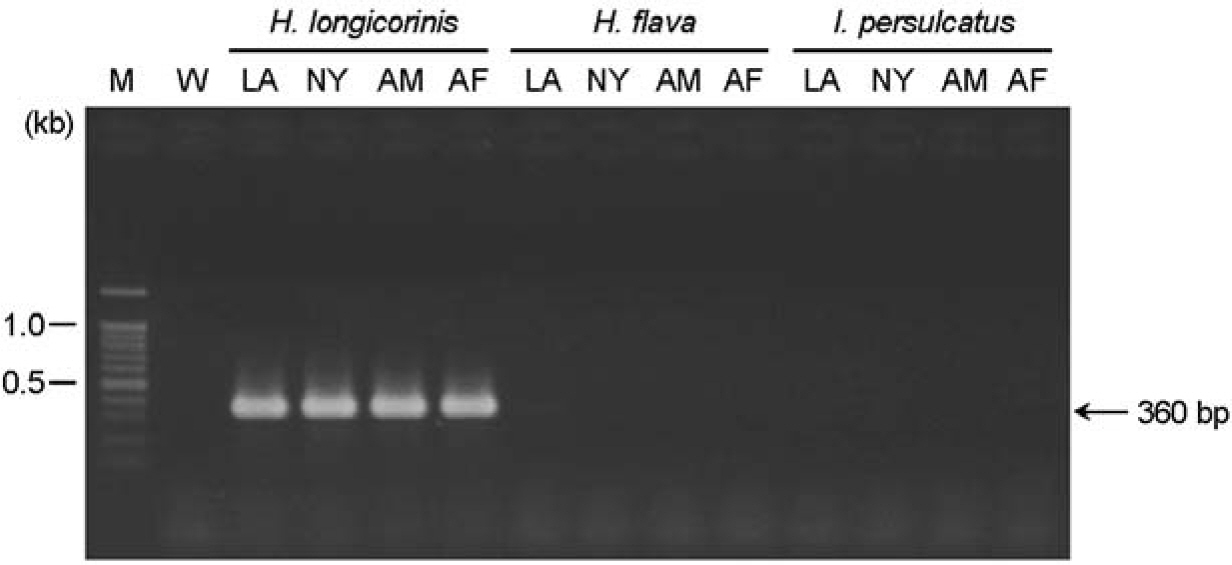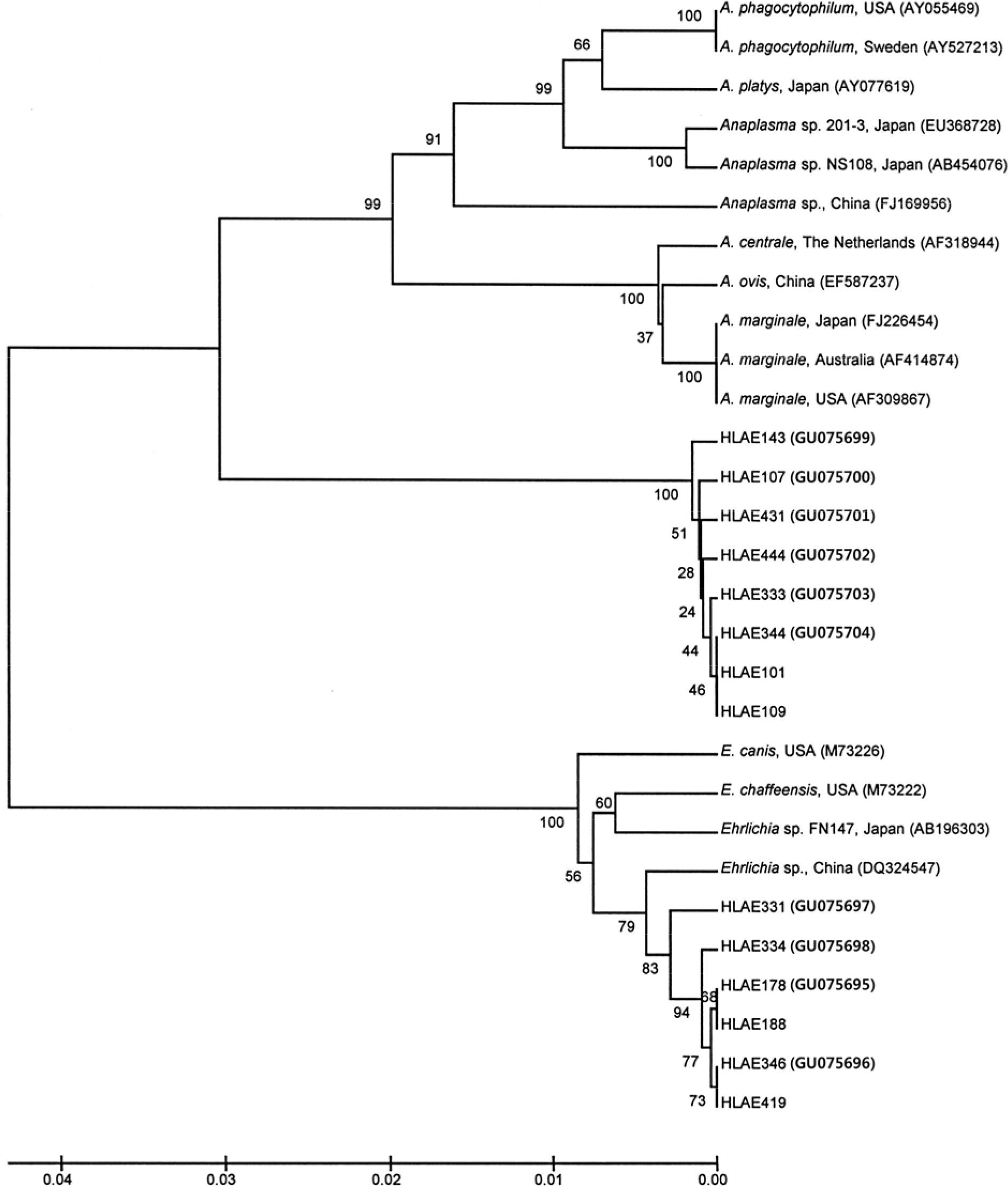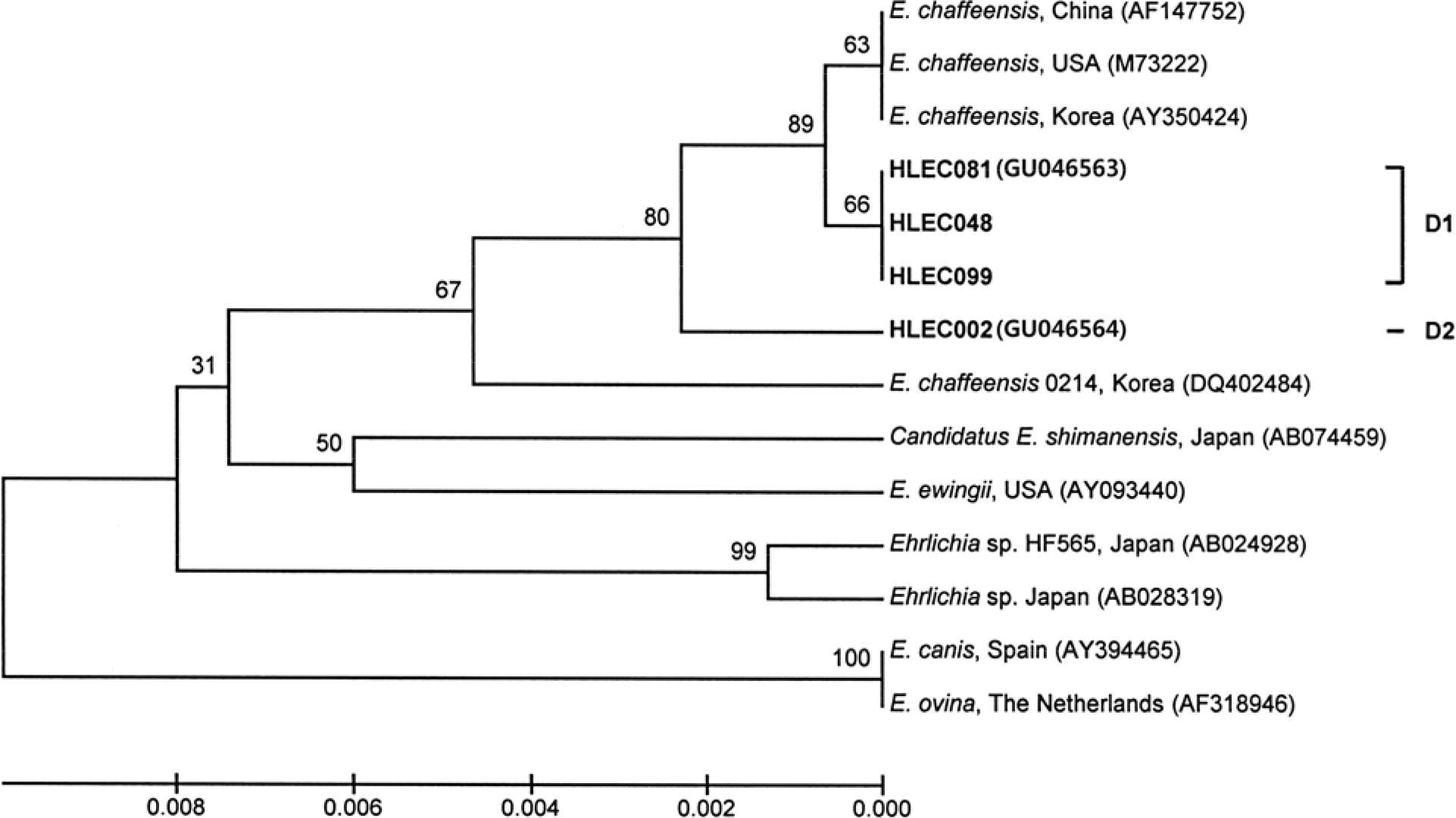J Bacteriol Virol.
2009 Dec;39(4):257-267. 10.4167/jbv.2009.39.4.257.
Genetic Identification and Phylogenetic Analysis of Anaplasma and Ehrlichia Species in Haemaphysalis longicornis Collected from Jeju Island, Korea
- Affiliations
-
- 1Department of Internal Medicine, Research Institute for Veterinary Science and College of Veterinary Medicine, Seoul National University, Seoul, Korea. jschae@snu.ac.kr
- 2Department of Microbiology, College of Veterinary Medicine, Seoul National University, Seoul, Korea.
- 3Institute of Environmental Resource Research of Jeju Special Self-Governing Province, Jeju, Korea.
- 4Department of Medical Entomology, Korea Center for Disease Control and Prevention, Seoul, Korea.
- 5Department of Food Biotechnology, Cheju National University, Jeju, Korea.
- KMID: 2168537
- DOI: http://doi.org/10.4167/jbv.2009.39.4.257
Abstract
- A total of 1,395 Haemaphysalis longicornis ticks collected from Jeju Island of Korea were examined by 16S rRNA gene-based nested PCR for the presence of infection with Anaplasma and Ehrlichia species. Template DNAs to detect the tick-borne pathogens were prepared from a total 506 tick pools. Eight genera of Anaplasma and six Ehrlichia by 16S rRNA gene PCR and sequencing analysis were identified. A. phagocytophilum was the most prevalent (27 [1.9%]) by nested PCR, followed by A. bovis (5 [0.4%]), E. chaffeensis (4 [0.2%]), and A. centrale (1 [0.1%]). In the phylogenetic analysis based on 16S rRNA sequences, eight genera of Anaplasma group (> 99.4% homology) and six Ehrlichia group (> 99.5% homology) were close to deposited A. marginale strains (AF309867, AF414874, and FJ226454) and Ehrlichia sp. (DQ324547), respectively. Three Anaplasma species groups A. phagocytophilum (group A), A. bovis (group B), and A. centrale (group C) and one Ehrlichia species E. chaffeensis (group D) were determined by comparing with Anaplasma and Ehrlichia related sequences. First, twenty-eight A. phagocytophilum clones belonging to group A were divided into 7 genotypes. The sequence similarity among genotypes A1 to A4 was very high (> 99.6%). Genotype B2 was close to A. bovis from Korea (99.7%). Genotype D1 was close to known E. chaffeensis strains (M73222, AF147752, and AY350424) and their similarity value was 99.7%. In conclusion, the genera of Anaplasma/Ehrlichia, A. phagocytophilum, and E. chaffeensis identified in predominant H. longicornis ticks were ubiquitous throughout the Jeju Island. The various native groups have been found through sequence identities and phylogenetic analysis.
Keyword
MeSH Terms
Figure
Cited by 1 articles
-
Prevalence of Anaplasma, Bartonella and Borrelia Species in Haemaphysalis longicornis collected from goats in North Korea
Jun-Gu Kang, Sungjin Ko, W. Barney Smith, Heung-Chul Kim, In-Yong Lee, Joon-Seok Chae
J Vet Sci. 2016;17(2):207-216. doi: 10.4142/jvs.2016.17.2.207.
Reference
-
1). Dumler JS., Bakken JS. Ehrlichial diseases of humans: emerging tick-borne infection. Clin Infect Dis. 1995. 20:1102–10.2). Murphy GL., Ewing SA., Whitworth LC., Fox JC., Kocan AA. A molecular and serologic survey of Ehrlichia canis, E. chaffeensis, and E. ewingii in dogs and ticks from Oklahoma. Vet Parasitol. 1998. 79:325–39.3). Inokuma H., Ohno K., Onishi T., Raoult D., Brouqui P. Detection of ehrlichial infection by PCR in dogs from Yamaguchi and Okinawa Prefectures, Japan. J Vet Med Sci. 2001. 63:815–7.
Article4). Heo EJ., Park JH., Koo JR., Park MS., Park MY., Dumler JS., Chae JS. Serologic and molecular detection of Ehrlichia chaffeensis and Anaplasma phagocytophila (human granulocytic ehrlichiosis agent) in Korean patients. J Clin Microbiol. 2002. 40:3082–5.5). Kawahara M., Rikihisa Y., Lin Q., Isogai E., Tahara K., Itagaki A., Hiramitsu Y., Tajima T. Novel genetic variants of Anaplasma phagocytophilum, Anaplasma bovis, Anaplasma centrale, and a novel Ehrlichia sp. in wild deer and ticks on two major Islands in Japan. Appl Environ Microbiol. 2006. 72:1102–9.6). Bakken JS., Dumler JS. Human granulocytic ehrlichiosis. Clin Infect Dis. 2000. 31:554–60.
Article7). Dumler JS., Choi KS., Garcia-Garcia JC., Barat NS., Scorpio DG., Garyu JW., Grab DJ., Bakken JS. Human granulocytic anaplasmosis and Anaplasma phagocytophilum. Emerg Infect Dis. 2005. 11:1828–34.8). Uchida T., Yan Y., Kitaoka S. Detection of Rickettsia japonica in Haemaphysalis longicornis ticks by restriction fragment length polymorphism of PCR product. J Clin Microbiol. 1995. 33:824–8.9). Shimada Y., Inokuma H., Beppu T., Okuda M., Onishi T. Survey of Ixodid tick species on domestic cats in Japan. Vet Parasitol. 2003. 111:231–9.10). Kim CM., Yi YH., Yu DH., Lee MJ., Cho MR., Desai AR., Shringi S., Klein TA., Kim HC., Song JW., Baek LJ., Chong ST., O'Guinn ML., Lee JS., Lee IY., Park JH., Foley J., Chae JS. Tick-borne rickettsial pathogens in ticks and small mammals in Korea. Appl Environ Microbiol. 2006. 72:5766–76.
Article11). Sun J., Liu Q., Lu L., Ding G., Guo J., Fu G., Zhang J., Meng F., Wu H., Song X., Ren D., Li D., Guo Y., Wang J., Li G., Liu J., Lin H. Coinfection with four genera of bacteria (Borrelia, Bartonella, Anaplasma, and Ehrlichia) in Haemaphysalis longicornis and Ixodes sinensis ticks from China. Vector Borne Zoonotic Dis. 2008. 8:791–5.12). Jilintai ., Seino N., Hayakawa D., Suzuki M., Hata H., Kondo S., Matsumoto K., Yokoyama N., Inokuma H. Molecular survey for Anaplasma bovis and Anaplasma phagocytophilum infection in cattle in a pastureland where sika deer appear in Hokkaido, Japan. Jpn J Infect Dis. 2009. 62:73–5.13). Kim CM., Kim MS., Park MS., Park JH., Chae JS. Identification of Ehrlichia chaffeensis, Anaplasma phagocytophilum, and A. bovis in Haemaphysalis longicornis and Ixodes persulcatus ticks from Korea. Vector Borne Zoonotic Dis. 2003. 3:17–26.14). Lee JH., Park HS., Jung KD., Jang WJ., Koh SE., Kang SS., Lee IY., Lee WJ., Kim BJ., Kook YH., Park KH., Lee SH. Identification of the spotted fever group rickettsiae detected from Haemaphysalis longicornis in Korea. Microbiol Immunol. 2003. 47:301–4.15). Yu DH., Li YH., Yoon JS., Lee JH., Lee MJ., Yu IJ., Chae JS., Park JH. Ehrlichia chaffeensis infection in dogs in South Korea. Vector Borne Zoonotic Dis. 2008. 8:355–8.16). Kawahara M., Rikihisa Y., Lin Q., Isogai E., Tahara K., Itagaki A., Hiramitsu Y., Tajima T. Novel genetic variants of Anaplasma phagocytophilum, Anaplasma bovis, Anaplasma centrale, and a novel Ehrlichia sp. in wild deer and ticks on two major islands in Japan. Appl Environ Microbiol. 2006. 72:1102–9.17). Yamaguti N., Tipton VJ., Keegan H., Toshioka S. Ticks of Japan, Korea, and the Ryukyu islands. Brigham Young Univ Sci Bull Biol Ser. 1971. 15:1–126.18). Chae JS., Kim CM., Kim EH., Hur EJ., Klein TA., Kang TK., Lee HC., Song JW. Molecular epidemiological study for tick-borne disease (Ehrlichia and Anaplasma spp.) surveillance at selected U.S. military training sites/installations in Korea. Ann N Y Acad Sci. 2003. 990:118–25.19). Lee SO., Na DK., Kim CM., Li YH., Cho YH., Park JH., Lee JH., Eo SK., Klein TA., Chae JS. Identification and prevalence of Ehrlichia chaffeensis infection in Haemaphysalis longicornis ticks from Korea by PCR, sequencing and phylogenetic analysis based on 16S rRNA gene. J Vet Sci. 2005. 6:151–5.20). Chae JS., Yu do H., Shringi S., Klein TA., Kim HC., Chong ST., Lee IY., Foley J. Microbial pathogens in ticks, rodents and a shrew in northern Gyeonggi-do near the DMZ, Korea. J Vet Sci. 2008. 9:285–93.
Article21). Ooshiro M., Zakimi S., Matsukawa Y., Katagiri Y., Inokuma H. Detection of Anaplasma bovis and Anaplasma phagocytophilum from cattle on Yonaguni Island, Okinawa, Japan. Vet Parasitol. 2008. 154:360–4.
- Full Text Links
- Actions
-
Cited
- CITED
-
- Close
- Share
- Similar articles
-
- Identification and prevalence of Ehrlichia chaffeensis infection in Haemaphysalis longicornis ticks from Korea by PCR, sequencing and phylogenetic analysis based on 16S rRNA gene
- Prevalence of Anaplasma, Bartonella and Borrelia Species in Haemaphysalis longicornis collected from goats in North Korea
- Coinfection of Severe Fever With Thrombocytopenia Syndrome Virus and Coxiella burnetii in Developmental Stage of Hard Ticks in Subtropical Region of Korea
- Detection of Anaplasma sp. in Korean Native Goats (Capra aegagrus hircus) on Jeju Island, Korea
- No Detection of Severe Fever with Thrombocytopenia Syndrome Virus from Ixodid Ticks Collected in Seoul






